

European Users of the Express Pallet
Instrument Proposal Datasheet
This questionnaire is intended to allow the capture of sufficient technical information on the proposed instruments to allow ESA to make a preliminary engineering assessment of its accommodation on, and compatibility with, the Express Pallet and the associated Space Station infrastructure.
PART TITLE HANDBOOK
CHAPTER
1 Key Personnel 2
2 Instrument Description 3
3 Instrument Envelope(s) 4
4 Instrument Field of View 4
5 Instrument Mass 4
6 Instrument Method of Attachment 5
7 Instrument Alignment/Pointing Requirements 3,5
8 Instrument Temperature Limits 6,7
9 Instrument Thermal Properties 6
10 Instrument Heat Generation Profile 6
11 Instrument Environmental Characteristics &
Requirements 6,12
12 Instrument Power Demands 7
13 Instrument Data Handling Requirements 8
14 Payload/Instrument Applications Software
Requirements 9
15 Instrument On Board Command&Data Acquisition
Requirements 9,11
16 Instrument On-ground Telemetry & Telecommand
Requirements 9,11
17 Instrument Development and Test Philosophy 10,12,13
18 Instrument Pre-launch Requirements 11
19 Instrument Logistics Flight &
Installation/Deinstallation Requirements 11
20 Instrument Post-landing Requirements 11
21 Instrument Mission & Operations Requirements 11
........................
ISSUE.............

This Instrument Questionnaire is the technical document substantiating the proposal of
(name)
.............................................................................................................................
(institution)
.............................................................................................................................
prepared in answer to the ESA Announcement of Opportunity
AO
.............................................................................................................................
to supply the payload instrument:
(name)
.............................................................................................................................
(signature)................................................
(date).....................................................
European Space Agency:
Signing Authority: Name:....................................
Address:.................................
Tel.:............. Fax.:................
E'mail:..................................
Technical Name:....................................
Representative: Address:.................................
Tel.: ............ Fax.:................
E'mail:..................................
User:
Signing Authority: Name:....................................
Address:.................................
Tel.:............. Fax.:................
E'mail:..................................
Principal Name:....................................
Investigator: Address:.................................
Tel.:............. Fax.:................
E'mail:..................................
Technical Name:....................................
Representative: Address:.................................
Tel.:............. Fax.:................
E'mail:..................................
Instrument Name:....................................
Developer Address:.................................
Tel.:............. Fax.:................
E'mail:..................................
Give only a brief summary here since the scientific background shall be explained in detail in the main part of your proposal.
(1) Instrument or Experiment Discipline
Earth Observation............... Physical Sciences...........
Biology......................... Solar Observation...........
Astronomy....................... Space Environment...........
Technology...................... Commercial..................
Others..........................
(2) Scientific Objectives:
(3) Envisaged Scientific Return:
(4) Previous Space Application of Interest:
(5) Development Plan and Schedule:
(6) Management Plan:
(7) Funding Status:
(8) Description of Instrument - Checklist :
Item Attached Not Yet Not
Available Applicable
Functional Block Diagrams:-
(8) Instrument Physical/Environmental Requirements - Checklist:
(9) Instrument C/O and Operations Requirements - Checklist :
(10) Instrument General Arrangement
Note: The Candidate User's own drawings may be attached to this Part.
Note: The Candidate User's own drawings may be attached to this Part.
(1) Physical Description.
An instrument may be composed of several configuration items. Name them, List their function and provide drawings.

Numbering of items to be identical in parts 3, 5, 8, 9 and 12
(2) Dimensions

Numbering of items to be identical in parts 3, 5, 8, 9 and 12
Provide dimensions for the stowed envelope or overall envelope if there are no deployments. State constraints on the physical relationship between items.
Provide dimensions for the maximum kinematic envelope (deployed appendages or envelope of volume necessary when using a pointing element) when the payload is operating.
Note: The Candidate User's own drawings may be attached to this Part.
(1) Viewing or Exposure Requirements
Viewing / Exposure Directions:-
(2) Field of View Drawings (see Annex 1 for Example)

Numbering of items to be identical in parts 3, 5, 8, 9 and 12
The total mass is assumed to include development risk margins.
Note: The Candidate User's own drawings may be attached to this Part.
(1) Interface Drawings (see Annex 2 for Example)
(1) Pointing requirements
The instrument requires the Coarse Pointing Device (CPD):
The instrument has its own pointing system:
(2) Instrument intrinsic performance:
Pointing accuracy (degree or arcsec at 1s):
Stability (±TBD degree or arcsec over TBD seconds at 1s):
(3) Please explain your requirements and concept:
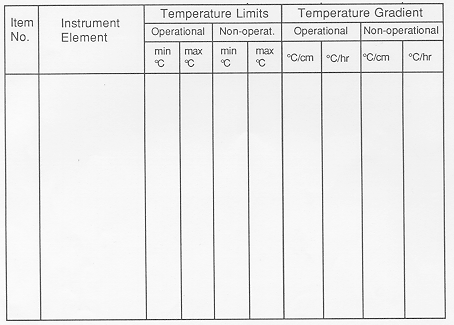
Numbering of items to be identical in parts 3, 5, 8, 9 and 12

Numbering of items to be identical in parts 3, 5, 8, 9 and 12
Does the Instrument have an independent cooling system?

Numbering of items to be identical in parts 3, 5, 8, 9 and 12
For the purposes of describing variable heat generation (an "operations cycle"), please describe an irreducible observation or experiment cycle such as a complete observation, a pointing event or a set of experiment steps and measurements. Give the duration of the cycle and the conditions under which it may be suspended or aborted.
Note: These data may be submitted in graphical form, ie; as a chart showing heat dissipation (W) versus time for a) complete mission and b) an operations cycle).
(1) Environment Induced by the Instrument
RF fields produced by the instrument

Magnetic fields produced by the instrument

Microgravity disturbance caused by the instrument:-
The instrument has internal moving parts:
The instrument has an internal stabilization system:
The instrument generates vibrations in one or more of its operation modes:
If yes, please explain in detail, specifying levels and durations.
Contamination:-
Is Contamination produced by the instrument (eg; outgassing, shedding of particulate matter):
If yes, please explain in detail.
(2) Environmental Susceptibilities of the Instrument
Instrument sensitive to RF fields
If yes, state the effect on the instrument, scientific results, etc. and describe the method of shielding.
Instrument sensitive to magnetic fields
If yes, state the effect on the instrument, scientific results etc. and describe the method of shielding.
Instrument sensitive to microgravity disturbance:-
The unit has specific microgravity requirements (µg levels)
If yes, please specify, levels and durations.
(3) General Susceptibilities to Contamination;
List contamination types to which the instrument may be sensitive.
For each contamination type, fill in the table below:-
Impact of the components of the natural and induced space station environment on the instrument
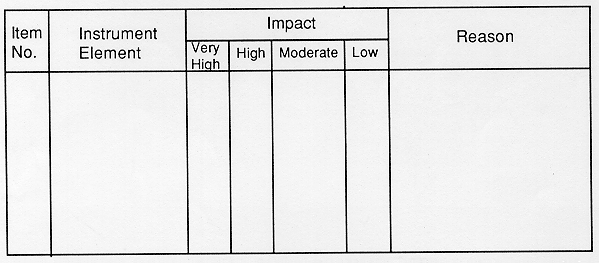
Low impact: the instrument can continue to function as intended during non-quiescent periods.
Moderate impact: the instrument can not function as intended during non-quiescent periods, however the instrument may continue to be operated in a degraded mode without harm in these periods.
High impact: the instrument can not function in non-quiescent periods and must be temporarily shut down to avoid harm.
Very high impact: the instrument can not function in non-quiescent periods. To avoid harm it must be temporarily shut down and additional protection systems must be activated.
(1) Instrument Power Demands During Mission
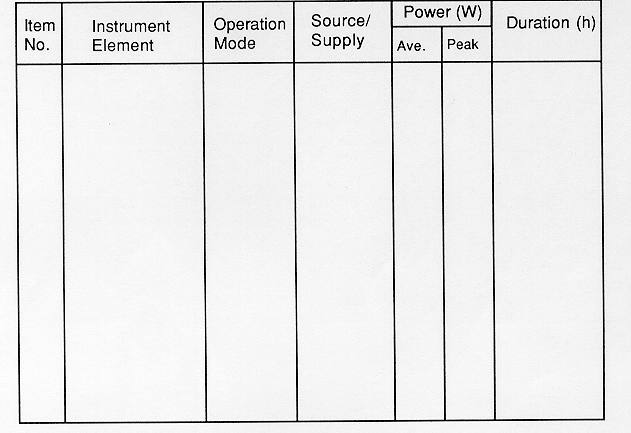
Numbering of items to be identical in parts 3, 5, 8, 9 and 12
Does the instrument have an independent power source?
(2) Power Demand During Pre-Launch and Post Landing Ground Phases
(3) Instrument Power Profile
For the purposes of describing variable resource use (an "operations cycle"), please describe an irreducible observation or experiment cycle such as a complete observation, a pointing event or a set of experiment steps and measurements. Give the duration of the cycle and the conditions under which it may be suspended or aborted. If the cycle chosen is the same as for Part 10, all that is needed is for this to be indicated.
Note: These data may be submitted in graphical form, ie; as a chart showing power consumption (W) versus time for a) complete mission and b) an operations cycle).
Phase/Activity Power (w) Duration ______________________________________________________________
(4) Instrument Grounding
Does the instrument comply with EXPRESS Pallet requirements?
(1) Instrument/EXPRESS Pallet Interface
(3) Data Rates via EXPRESS Pallet MIL-STD-1553B bus
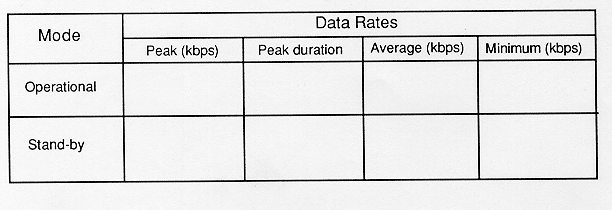
(4) Is the HRDL required?
(9) Data Acquisition Profile
Source of data:
Data Generation Profile
For the purposes of describing variable resource use (an "operations cycle"), please describe an irreducible observation or experiment cycle such as a complete observation, a pointing event or a set of experiment steps and measurements. Give the duration of the cycle and the conditions under which it may be suspended or aborted. If the cycle chosen is the same as for Part 10, all that is needed is for this to be indicated.
Note: These data may be submitted in graphical form, ie; as a chart showing data acquisition (bps) versus time for a) a complete mission, b) an operations cycle.
Phase/Activity Duration Net Data Generation Rate (bps) Remarks _____________________________________________________________________________
(10) Instrument Schedule/Timeline
(1) Type of data required by crew
(2) Are real time data required?
(7) Command Data Transmission Profile
For the purposes of describing variable resource use (an "operations cycle"), please describe an irreducible observation or experiment cycle such as a complete observation, a pointing event or a set of experiment steps and measurements. Give the duration of the cycle and the conditions under which it may be suspended or aborted. If the cycle chosen is the same as for Part 10, all that is needed is for this to be indicated.
Note: These data may be submitted in graphical form, ie; as a chart showing
command transmission versus time for a) a complete mission, b) an
operations cycle.
Phase/Activity Duration Command Data Rate (bps) Remarks
___________________________________________________________________________
(1) Applied Instrument Model Philosophy
(2) Instrument Test, Acceptance and Qualification Approach
(3) Description of Instrument Test Equipment
(1) Nominal Payload Processing Requirements in tbd location(s)
- Removal/Replacement of Items
(1) During Transportation
Temperature monitoring is required;
(1) Nominal Payload Processing Requirements in tbd location(s)
- Removal of Items
(1) Required Mission Profile
For the purposes of describing a variable profile (an "operations cycle"), please describe an irreducible observation or experiment cycle such as a complete observation, a pointing event or a set of experiment steps and measurements. Give the duration of the cycle and the conditions under which it may be suspended or aborted. If the cycle chosen is the same as for Part 10, all that is needed is for this to be indicated.
Note: These data may be submitted in graphical form, ie; as a chart the a) a mission profile, b) an operations cycle.
Phase/Activity Duration Explanation ________________________________________________________________________
A. Field of View Drawing Example.
B. Interface Drawing Example.

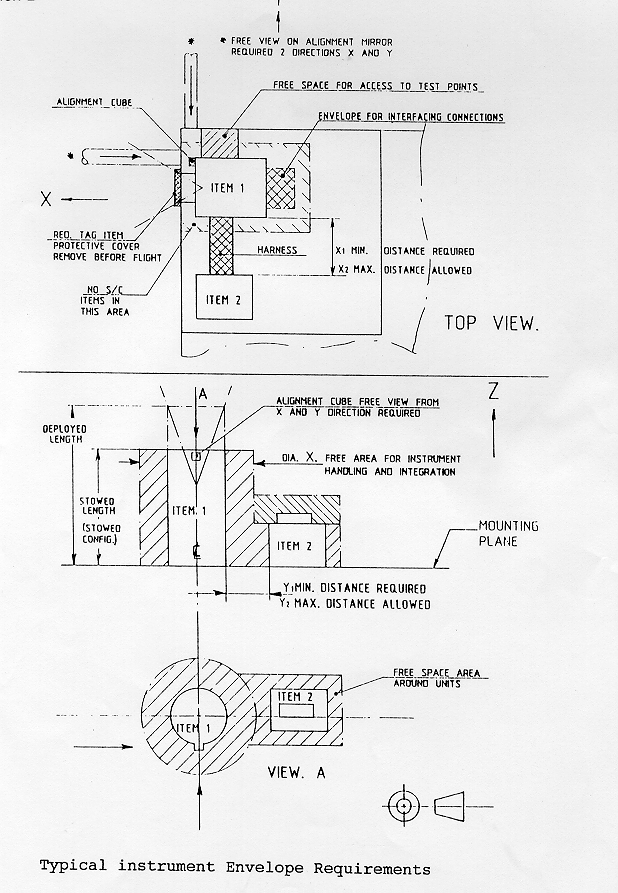



 SP1201
SP1201